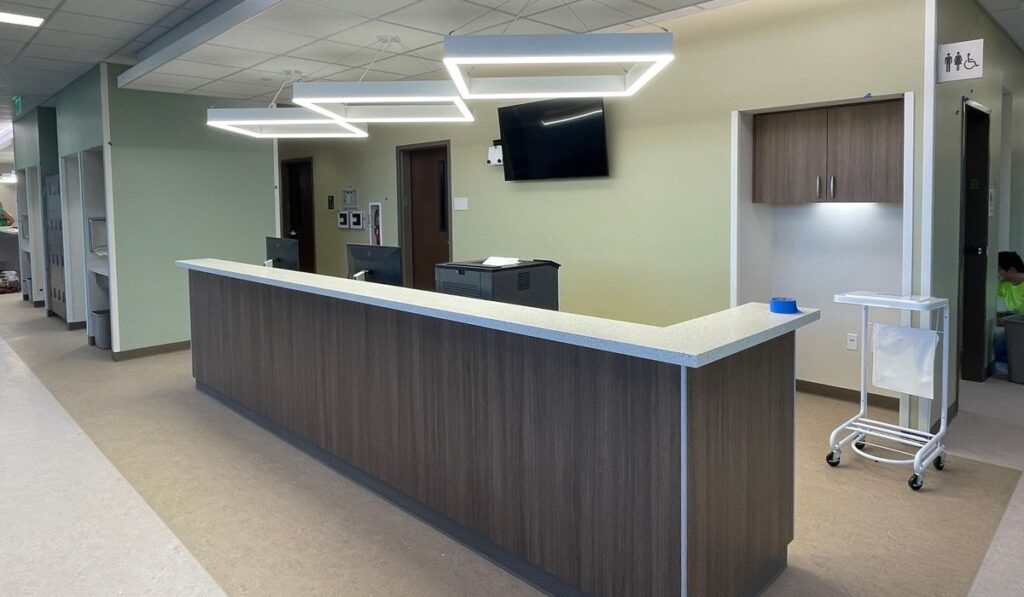If you’re managing a healthcare facility, you know how critical the environment is for patients and staff alike. That includes everything from the lighting and flooring to something that might seem simple at first: the paint on the walls. Interior commercial painters who understand the unique needs of medical environments are not just helpful—they’re essential. And when it comes to healthcare facility painting, there’s a lot more at stake than just aesthetics.
Painting in a hospital or clinic isn’t the same as painting an office or retail space. It requires planning, safety precautions, specialized materials, and a deep understanding of infection control protocols. In this article, we’ll break down why specialized painting in healthcare environments matters, what to look for in a contractor, and how the right choices can protect your patients, your staff, and your facility’s reputation.
Key Takeaways:

Why Is Specialized Painting Needed in Healthcare Facilities?
Healthcare environments are held to a much higher standard than commercial or residential spaces. The presence of immunocompromised patients, strict cleanliness standards, and regulatory oversight means that even paint jobs must meet specific requirements.
Infection Control Comes First
In medical settings, paint must not contribute to the spread of bacteria, mold, or allergens. Traditional paints can emit volatile organic compounds (VOCs) that may irritate patients or staff. Using low-VOC or zero-VOC paint, as well as antimicrobial coatings, is a standard best practice.
Durability and Cleanability
Walls in healthcare settings need to withstand frequent cleaning and occasional scrubbing with disinfectants. Specialized paint ensures that the finish remains intact, even with constant maintenance.
Safety and Compliance
OSHA and other regulatory bodies may have specific guidelines for healthcare environments. Using approved materials and ensuring proper ventilation during the painting process helps maintain compliance.
What Makes a Great Interior Commercial Painter for Medical Environments?
Hiring just any painter won’t do. Healthcare facilities need interior commercial painters with specific experience in:
Look for painters who:
This is where experience really matters. Contractors who specialize in healthcare facility painting know how to plan projects around your facility’s daily operations.
What Types of Paint Should Be Used in Healthcare Facilities?
Not all paints are created equal—especially when it comes to healthcare spaces. Here are some top expert-approved picks that stand out for performance, safety, and style.
1. Low-VOC or Zero-VOC Paints
These paints significantly reduce the emission of harmful chemicals, such as volatile organic compounds (VOCs), which can cause respiratory issues and other health problems. By minimizing these emissions, they help maintain a healthier indoor environment, especially critical for patients with weakened immune systems and respiratory conditions.
2. Antimicrobial Coatings
These coatings are specially formulated with antimicrobial agents that inhibit the growth of harmful microorganisms like bacteria and mold on painted surfaces. This is particularly important in areas prone to moisture or high-touch surfaces, where microbial growth can pose serious health risks to patients and staff.
3. High-Performance Epoxy Paints
These paints are ideal for high-traffic or high-use areas within healthcare facilities, such as emergency rooms, corridors, and exam rooms, where surfaces are subject to frequent scrubbing with harsh disinfectants. Their robust composition ensures long-lasting performance, even under constant cleaning and wear.
4. Washable and Scrubbable Paint Finishes
These finishes are crucial in spaces like operating rooms, patient rooms, and high-touch areas because they allow for frequent cleaning and disinfecting without degrading the surface, helping to maintain hygiene and extend the life of the paint job.
5. Non-slip Floor Coatings
These coatings help prevent slips and falls by providing traction in moisture-prone areas like bathrooms, kitchens, and laundry facilities—making them a crucial safety feature in healthcare settings where patient and staff mobility must be protected.
Each surface in a medical facility may require a different solution, and a knowledgeable contractor will recommend the right product for each space.

How Does Specialized Painting Impact Patient and Staff Safety?
It’s not just about how it looks—it’s about how it functions. A well-executed healthcare facility painting project can:
For instance, a freshly painted waiting room with calming colors and clean finishes can reduce patient anxiety. Similarly, staff working in a well-maintained and aesthetically pleasing environment are likely to feel more positive and productive.
What Are the Logistics of Painting an Active Healthcare Facility?
The logistics are complex. That’s why specialized painting contractors work closely with facility managers to:
How Often Should Healthcare Facilities Repaint?
This depends on the area. High-traffic zones may need repainting every 3-5 years. Patient rooms and hallways may require touch-ups more frequently. But repainting isn’t just cosmetic—it’s about maintaining safety and cleanliness standards.
What Should You Ask Before Hiring a Healthcare Painting Contractor?

Final Thoughts: Invest in Safety, Compliance, and Peace of Mind
Choosing experienced interior commercial painters who specialize in healthcare facility painting isn’t just a maintenance task—it’s a vital part of running a safe, compliant, and welcoming medical environment. When you partner with experts who understand the stakes, you’re protecting your patients, supporting your staff, and enhancing your facility’s reputation.
Looking for a healthcare painting partner who gets it right the first time? Contact H&H Painting Co. at 269-748-0933 to schedule a consultation. We’ll help you create a cleaner, safer, and more professional space—with minimal disruption to your daily operations.





